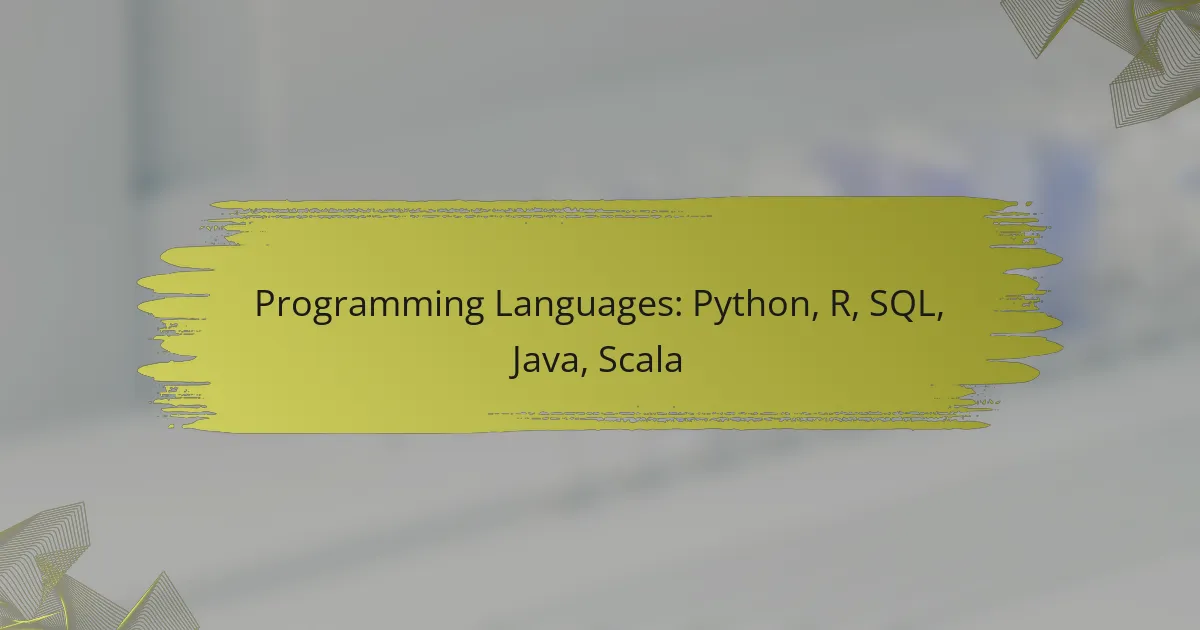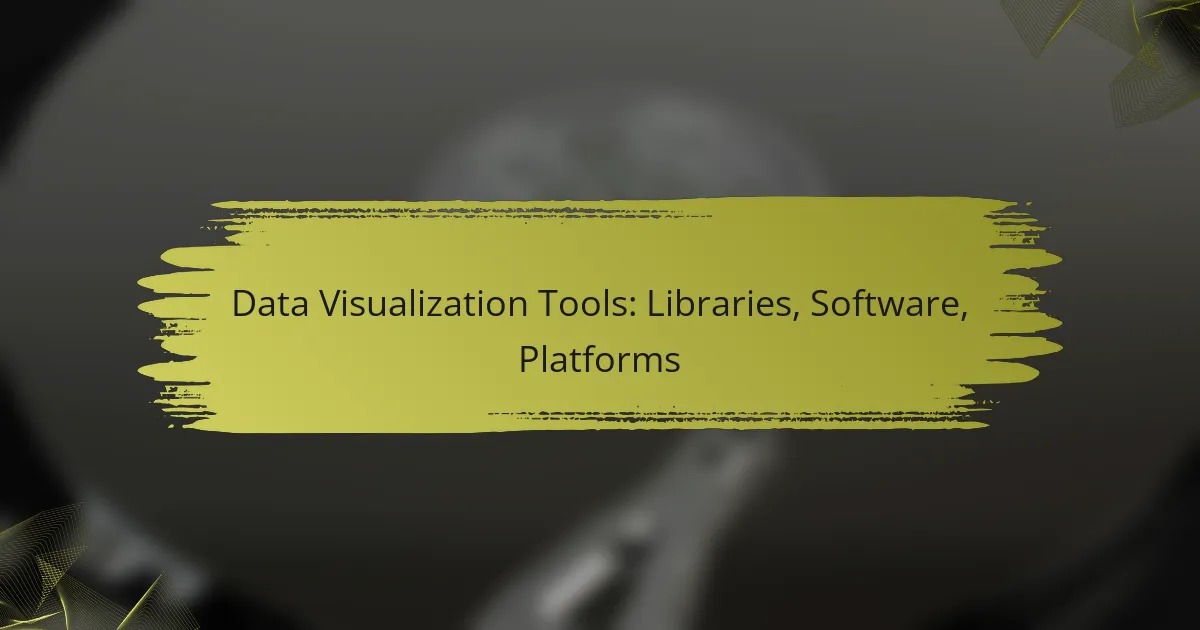In 2023, programming languages such as Python, R, SQL, Java, and Scala are essential tools across various industries, serving diverse purposes from web development to data analysis. Choosing the right language depends on your project requirements and personal expertise, with Python and R being favored for data science due to their unique strengths in analysis and visualization. Meanwhile, SQL remains crucial for database management, while Java and Scala are often utilized in large-scale applications and data processing tasks.

Which programming languages are most popular in 2023?
In 2023, the most popular programming languages include Python, Java, JavaScript, R, and SQL. These languages are widely used across various industries for tasks ranging from web development to data analysis.
Python
Python remains a top choice for developers due to its simplicity and versatility. It is commonly used in web development, data science, artificial intelligence, and automation.
With a rich ecosystem of libraries like Pandas, NumPy, and TensorFlow, Python facilitates quick development and prototyping. Its readability and community support make it an ideal language for beginners and experienced programmers alike.
Java
Java is a robust, object-oriented programming language that is widely used in enterprise environments. Its platform independence, thanks to the Java Virtual Machine (JVM), allows applications to run on any device with the JVM installed.
Java is particularly strong in building large-scale applications and Android app development. Its extensive libraries and frameworks, such as Spring and Hibernate, provide tools for efficient development.
JavaScript
JavaScript is essential for web development, enabling interactive and dynamic web pages. It runs in the browser and is supported by all major web browsers, making it a cornerstone of front-end development.
With the rise of frameworks like React, Angular, and Vue.js, JavaScript has expanded its capabilities, allowing developers to create complex single-page applications. Its asynchronous nature and event-driven architecture enhance user experience.
R
R is a programming language specifically designed for statistical computing and data analysis. It is widely used among statisticians and data miners for developing statistical software and data visualization.
R’s extensive package ecosystem, including ggplot2 and dplyr, provides powerful tools for data manipulation and graphical representation. It is particularly favored in academia and research settings for its analytical capabilities.
SQL
SQL (Structured Query Language) is the standard language for managing and manipulating relational databases. It is crucial for data retrieval, insertion, updating, and deletion operations.
SQL is widely used in various applications, from small-scale projects to large enterprise systems. Understanding SQL is essential for data analysts and developers working with databases, as it allows for efficient data management and querying.

How to choose the right programming language for data science?
Selecting the right programming language for data science depends on your specific needs, project requirements, and personal proficiency. Python, R, SQL, and Java each offer unique strengths that cater to different aspects of data analysis, machine learning, and database management.
Python for machine learning
Python is widely regarded as the go-to language for machine learning due to its simplicity and extensive libraries such as TensorFlow and scikit-learn. Its readable syntax allows data scientists to quickly prototype models and iterate on their designs.
When choosing Python, consider its strong community support and numerous resources available for learning. However, be mindful of performance issues with large datasets, where optimized libraries or alternative languages might be necessary.
R for statistical analysis
R excels in statistical analysis and data visualization, making it a preferred choice for statisticians and data analysts. It offers a rich ecosystem of packages like ggplot2 and dplyr that facilitate complex data manipulation and graphical representation.
For projects focused on statistical modeling, R provides powerful tools and functions tailored for these tasks. However, its learning curve can be steeper for those unfamiliar with programming, so consider your team’s expertise before committing.
SQL for database management
SQL is essential for database management, allowing users to efficiently query and manipulate data stored in relational databases. It is particularly useful for extracting insights from large datasets and performing data aggregation tasks.
When working with SQL, ensure you understand the database structure and relationships between tables. A common pitfall is neglecting to optimize queries, which can lead to performance issues. Familiarity with SQL can significantly enhance your data handling capabilities in any data science project.

What are the key differences between Python and R?
Python and R are both popular programming languages used for data analysis and statistical computing, but they cater to different needs. Python is known for its versatility and ease of integration with other systems, while R excels in statistical analysis and data visualization.
Syntax and readability
Python is designed with readability in mind, using a clean and straightforward syntax that resembles natural language. This makes it easier for beginners to learn and understand. R, on the other hand, has a more complex syntax that can be less intuitive, especially for those unfamiliar with programming.
For example, a simple operation like calculating the mean of a list of numbers is straightforward in Python:
mean_value = sum(numbers) / len(numbers)
In R, the same operation is done using a built-in function:
mean_value <- mean(numbers)
Data visualization libraries
R is renowned for its powerful data visualization capabilities, primarily through libraries like ggplot2 and lattice. These tools allow for intricate and customizable visual representations of data, making R a favorite among statisticians and data scientists focused on visualization.
Python also offers strong visualization libraries, such as Matplotlib and Seaborn, which provide flexibility and integration with other Python tools. However, while Python’s libraries are robust, they may require more code to achieve the same level of detail as R's ggplot2.
Community support
Both Python and R have large, active communities that contribute to their development and support. Python's community is broader, encompassing web development, machine learning, and more, which leads to a wealth of resources and libraries.
R's community, while smaller, is highly focused on statistical analysis and data science, providing specialized support and packages tailored for these fields. Users can find numerous forums, tutorials, and documentation for both languages, but the type of support may vary based on specific use cases.

How does SQL integrate with other programming languages?
SQL integrates with various programming languages to enhance data manipulation and retrieval capabilities. By combining SQL with languages like Python, Java, and Scala, developers can leverage the strengths of each to build robust applications that handle data efficiently.
Python for data extraction
Python is widely used for data extraction due to its simplicity and powerful libraries such as Pandas and SQLAlchemy. These libraries allow developers to write SQL queries directly within Python scripts, making it easy to retrieve and manipulate data from databases.
For example, using the Pandas library, you can execute an SQL query and load the results into a DataFrame with just a few lines of code. This integration streamlines the process of data analysis and visualization, especially in data science projects.
Java for backend development
Java is a popular choice for backend development, particularly in enterprise applications that require robust database interactions. With JDBC (Java Database Connectivity), Java applications can connect to SQL databases, execute queries, and manage transactions effectively.
When using Java, consider employing frameworks like Hibernate, which simplifies database operations and improves code maintainability. This approach can reduce boilerplate code and enhance performance through features like caching and lazy loading.
Scala for big data processing
Scala is often used in big data processing, particularly with frameworks like Apache Spark, which supports SQL queries through its SQL API. This allows developers to write SQL-like queries to process large datasets efficiently within a distributed computing environment.
When working with Scala and Spark, you can easily integrate SQL queries with functional programming paradigms, enabling complex data transformations and analytics. This combination is particularly effective for handling real-time data streams and large-scale data processing tasks.

What are the advantages of using Java for enterprise applications?
Java offers several advantages for enterprise applications, including platform independence, robust security features, and strong community support. These characteristics make it a popular choice for large-scale systems that require reliability and scalability.
Platform independence
Java's platform independence is one of its most significant advantages. Applications written in Java can run on any device that has a Java Virtual Machine (JVM), allowing for greater flexibility in deployment. This means that enterprises can develop applications once and deploy them across various operating systems without needing extensive modifications.
This capability reduces development time and costs, as teams do not need to create separate versions for different platforms. It also simplifies maintenance and updates, as changes can be made in one codebase rather than multiple versions.
Robust security features
Java is designed with security in mind, incorporating several features that protect applications from vulnerabilities. The language includes a strong type system, automatic memory management, and a security manager that defines access controls for classes. These features help prevent common security issues like buffer overflows and unauthorized access.
Additionally, Java's extensive libraries provide built-in security protocols, such as encryption and authentication, which are essential for enterprise applications that handle sensitive data. Regular updates and patches from Oracle further enhance Java's security posture, making it a reliable choice for businesses.
Strong community support
The Java community is one of the largest and most active in the programming world. This strong support network means that developers can easily find resources, libraries, and frameworks to enhance their applications. Community forums, documentation, and tutorials are widely available, making it easier for new developers to learn and troubleshoot.
Moreover, the active community contributes to continuous improvements and innovations in the language. With a wealth of third-party tools and frameworks, such as Spring and Hibernate, enterprises can leverage existing solutions to accelerate development and improve application performance.

How to get started with Scala for big data?
To get started with Scala for big data, focus on understanding its integration with Apache Spark, a powerful framework for processing large datasets. Familiarize yourself with Scala's syntax and functional programming features, which are essential for efficient data manipulation and analysis.
Understanding Scala's Role in Big Data
Scala is a programming language that combines object-oriented and functional programming paradigms, making it ideal for big data applications. Its seamless interoperability with Java and concise syntax allows developers to write less code while maintaining performance. Scala is particularly popular in the big data ecosystem due to its compatibility with Apache Spark, which is widely used for distributed data processing.
Setting Up Your Scala Environment
To begin using Scala for big data, install the Scala SDK and a suitable IDE, such as IntelliJ IDEA or Eclipse with the Scala plugin. You can also use build tools like SBT (Scala Build Tool) to manage dependencies and compile your projects. Ensure you have Apache Spark installed, as it provides the necessary libraries for big data processing.
Learning Resources for Scala
Numerous resources are available to learn Scala effectively. Online platforms like Coursera and Udemy offer courses tailored to big data applications, while books such as "Programming in Scala" provide in-depth knowledge. Additionally, the official Scala documentation and community forums can be invaluable for troubleshooting and advanced topics.
Common Pitfalls to Avoid
When starting with Scala for big data, avoid common pitfalls such as neglecting to understand functional programming concepts, which are crucial for writing efficient code. Additionally, be cautious with Spark's lazy evaluation; ensure that you understand when transformations are executed to optimize performance. Lastly, familiarize yourself with Scala's type system to prevent runtime errors.



